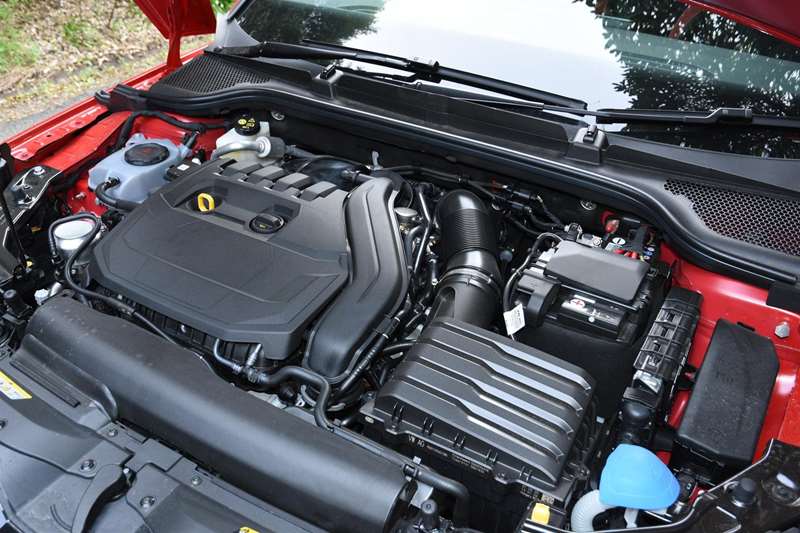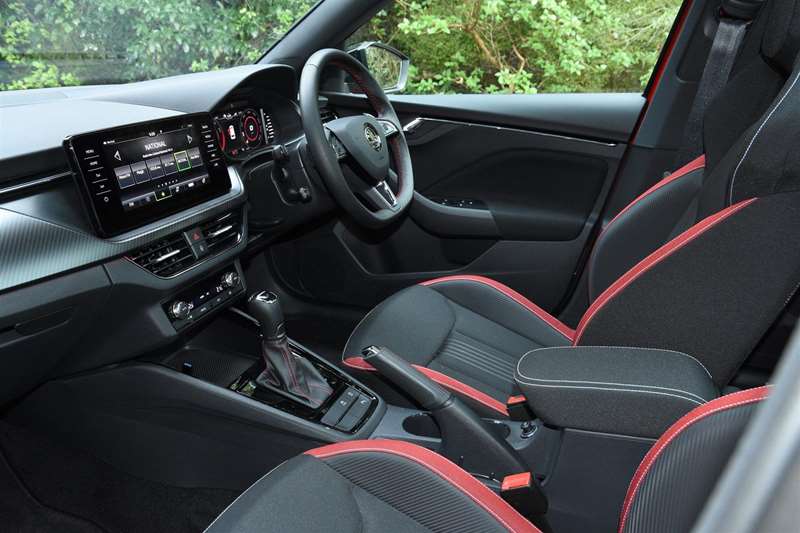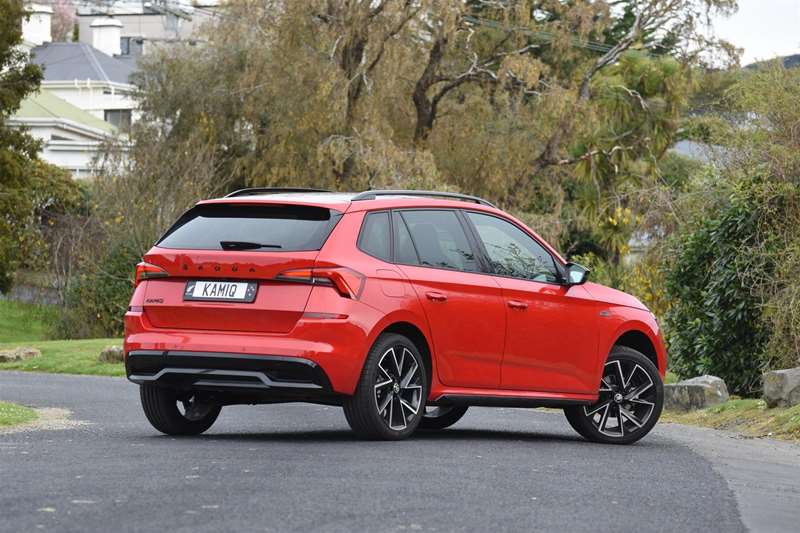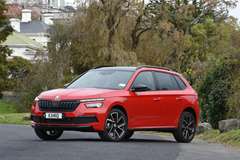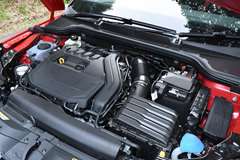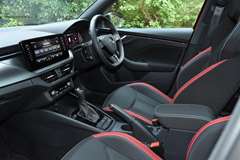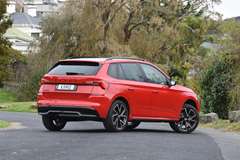Another week, another new compact SUV crossover to drive. That’s how it feels to David Thomson, with the Skoda Kamiq the latest vehicle of this type entrusted to his care for a road test.
What’s new?
Skoda’s SUV duo —Kodiaq and Karoq —has become a trio, with the addition of the Kamiq to the range.
Just announced as a finalist for 2020 New Zealand Car of Year honours, the Kamiq is built on the same VW Group platform as two other models tested in recent months —the Volkswagen T-Cross sport utility and the Skoda Scala hatchback. The choice of underlying platform dictates that, like the T-Cross, the Kamiq is only available as afrontwheel drive vehicle.
Although lower, narrower and appreciably shorter in overall length than the Kamiq, describing the new arrival as the smallest member of the Skoda SUV lineup isn’t quite accurate as in terms of wheelbase, the Kamiq is slightly longer than the Karoq.
There’s also considerable powertrain and price overlap between the Karoq and Kamiq, but that’s an increasingly common phenomenonfor carmakers as they add new crossover and conventional SUV models to meet blossoming global demand.
The Kamiq range is made up of the $30,990 85kW Ambition TSI, the $36,990 110KW Ambition Plus and the flagship $42,990 110kW Monte Carlo.
What comes as standard?
The entry level Ambition packs an 85kW/200Nm 1.0 litre three-cylinder petrol-turbo engine. As with the rest of the range, power delivery to the front wheels is via a sevenspeed DSG (dual-clutch) automatic transmission.
Riding on 16-inch alloys, and with LED headlights, the Ambition’s safety package includes lane assist and front assist with automated
Keyless entry, standard cruise control, auto lights and wipers, power heated mirrors, an eight-speaker sound system, manual air-conditioning, and 6.5-inch central touchscreen with smartphone mirroring are also provided.
Moving up to the Ambition Plus nets a 110kW/250Nm 1.5 litre four-cylinder turbo engine. There are 17-inch alloys, full keyless entry, dual-zone climate control, fancier interior lighting, and an eight-inch central touch screen.
The Monte Carlo justifies its $6000 price premium over the Ambition Plus with afair haul of extra kit. It sits on 18-inch alloys and slightly lower adaptive suspension, with adaptive bi-LED headlights and cornering lights, tinted glass and a panorama sunroof.
There’s also adaptive radar cruise control, side and rear cross traffic alert, sports seats and a sports steering wheel, and a 9.2-inch touchscreen and navigation system.
What’s it like to look at?
Testing the Karoq in 2018, I lamented Skoda’s decision to play it safe with a vehicle that replaced Skoda’s first modern SUV, the visually idiosyncratic Yeti.
Visual risk-taking isn’t part of the new Kamiq’s repertoire, either. What we have here is a nicely balanced, but utterly conventional contemporary SUV design.
The boldest trick the Kamiq plays up front is breaking with established convention by positioning its daytime running lights above, rather than below, the headlights. It’s a nice touch on a nose which is more upright than that of the Karoq. At the rear, the Kamiq echoes styling cues from the Scala hatchback, and follows that model in becoming the second modern Skoda to have the brand’s name writ large in chrome lettering across the tail.
Finished in eye-catching red, the test car’s styling benefited from a few flagship flourishes such as discreet ‘‘Monte Carlo’’ badging, black rather than chrome detailing, and those 18-inch black alloys.
What’s it like inside?
While the exterior of the Kamiq is largely underwhelming, the interior is quite striking, and practical, too.
Up front, the Monte Carlo’s sports seats look super with their body-hugging form, red and carbon-finish highlighting, and contrast stitching.
The dash is clean-lined, with soft-touch upper surfaces, while the large touchscreen plays a central role in eliminating button clutter: air-conditioning aside, pretty much everything is operated via either the touchscreen, which is very easy to navigate, or buttons on the multi-function steering wheel, and the stalks that surround it.
The main instrument cluster is fully digital —it’s Skoda’s version of the VWGroup excellent Virtual Cockpit system — and can be configured in many different ways (there are seven primary layouts alone) via buttons and a scroll wheel on the steering wheel.
The front seats are separated by a centre console, which includes a small lidded centre bin/armrest, twin cupholders, a conventional (rather than electronic) park brake, the gearshift and a tray at the base of the dashboard. The door pockets are deep and able to hold a 1.5-litre water bottle, while the driver’s side pocket boasts an umbrella holder. Felt lining for the glovebox and door pockets are also nice touches.
The Kamiq moves with the times in providing USB-C plugin points: two within the tray at the based of the console and two for back-seat occupants.
The benefits of a decent wheelbase are realised in the back seats, which are possessed of class-leading legroom as well as generous headroom. The continuation of red seat trimming from the front into the back seats, along with the panorama sunroof, give the rear of the cabin a spacious feeling, despite the choice of dark trim for the door pillars and roof lining.
Boot space is a very reasonable 400 litres, expanding to 1395 litres when the rears seats are folded down. The main boot cavity features adjustable cargo fasteners. Another neat convenience feature is the ice-scraper fitted on the inside of the fuel filler cap.
What’s it like to drive?
Manually-adjusting for squab height as well as back angle, the driver’s seat not only looks great, but is very comfortable, too. You sit lower in the Kamiq than in some other crossovers but, helped considerably by the vehicles quite slender A-Pillars, visibility is excellent.
Good visibility is, of course, key to easy round-town motoring. The Kamiq’s compact exterior dimensions and tight turning circle also help make manoeuvring narrow streets and parking spots a breeze and, so long as it’s not set in sport mode, the suspension soaks up city-street surface imperfections very well.
With peak torque produced from just 1500rpm, the engine is responsive at light throttle openings and aside from the occasional jerky gear change from the seven-speed DSG gearbox, this vehicle is a very smooth urban drive.
The drivetrain feels even more accomplished beyond the city limits, with ample pep for highway driving, including snappy overtaking when required. One does have to commit the button sequences for the adaptive cruise control to memory though, as the cruise control stalk is tucked out of sight behind the steering wheel spokes. Mechanical and wind roar are both well contained though road noise can become intrusive on coarse-chip surfaces.
There are other compact crossovers (not to mention many conventional hatchbacks) that offer greater rewards to the keen driver on winding tarmac back roads, but the Kamiq is never less than predictable and well-mannered when pushed. It is fine on gravel, too, remembering of course that it is a front-drive rather than 4WD.
In respect of economy, I returned a 6.3l/100km figure during an extended highway haul with a few backroad diversions thrown in. That compares reasonably well with the Kamiq’s 5.8l/100km standard cycle rating, which is very reasonable for a petrol-powered vehicle of this type.
Verdict
Beyond the play-it-safe exterior, the Kamiq offers plenty of appeal as an accomplished compact crossover. In 110kW guise it is decently peppy, and in favouring comfort and refinement over ultimate handling prowess, Skoda will surely meet the expectations of the majority of customers. The cabin is its real standout feature —well-finished and very roomy for a vehicle of this size and type.
Photos: David Thomson

